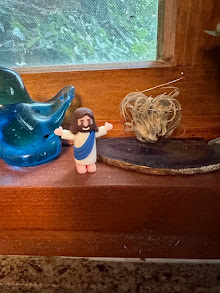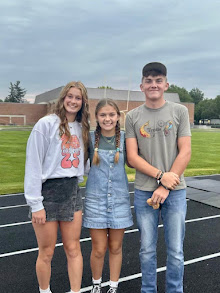 According to Wikipedia, barn raisings were common enough community affairs more than a century ago, but had pretty well been replaced by hired crews and commercial construction by the time my folks' 1912 barn was built. Nonetheless, it could still be a illustration for a children's book featuring a barn raising: post and beam, massive hay loft, shiny metal gambrel roof and classic red barn paint job. Years past, my sister and I both took turns climbing the tall ladder to paint the gable end of the barn; my father gave my mother untold nervous head aches stringing ladders across the roof to repair loose tin and repaint any stealthy incipient creeping rust invisible from the ground but sensed by my father's ultra sensitive preservation antennae. The tall ladder is retired now; a crew of Mennonites contracted to keep the roof silver last time around.
According to Wikipedia, barn raisings were common enough community affairs more than a century ago, but had pretty well been replaced by hired crews and commercial construction by the time my folks' 1912 barn was built. Nonetheless, it could still be a illustration for a children's book featuring a barn raising: post and beam, massive hay loft, shiny metal gambrel roof and classic red barn paint job. Years past, my sister and I both took turns climbing the tall ladder to paint the gable end of the barn; my father gave my mother untold nervous head aches stringing ladders across the roof to repair loose tin and repaint any stealthy incipient creeping rust invisible from the ground but sensed by my father's ultra sensitive preservation antennae. The tall ladder is retired now; a crew of Mennonites contracted to keep the roof silver last time around.
While barn raisings are an "example of a fundamental form of human cooperation" -, the extensive community of Hursts got together this week for another type of rural ritual: putting up sweet corn. My parents' farm garden had three or four long rows of sweet corn, protected by a thin electrified wire from things that go bump in the night and have unerring instincts for juicy kernels. But our family sweet corn patch is on a different scale completely, sown by a sixteen row planter and surrounded by rows and rows of field corn. This much corn demands a battle plan.
The driveway is crowded when I pull in; the number of pickups a dead giveaway that sweet corn is more than woman's work. A truck wide swath is mowed into the corn patch; the men pull the ears, then shuck them in the field. Corn fields in July are steamy stifling places; now a half dozen lawn chairs form a semicircle around the corn laden pickup parked under a shade tree. Farmers with dish towels wipe the silks from the ears, bringing canners, roasters, wash baskets full of shucked and dewormed ears to the house. Tall glasses of iced tea perch on the grass, all sticky from the sugary ears.
The canning kitchen downstairs spouts steam like a geyser field in Yellowstone and rattles like a 110 car unit train going over a bridge. Two canners 'double double toil and trouble' like Shakespeare's witches. Two sinks brim with cold water, ready to catch the steaming ears and cool them enough to cut. The stovetop is charred with carmelized corn juice. There is a rhythm to this job. Boil the water; feed the ears into the canner cautiously, dodging the boiling spray. When one pot comes to a rolling boil, shift the ears with tongs one by one to the sink of cool water. Check the other canner. Move cooler ears to even colder water. Fill the canner with more ears. Pull the corn from the second boiling canner. Fill a pan with cooler ears. Fill the sink with hot ears. Sound complicated? Not really. There is a rhythm.
In the garage, long plastic tables hold an assortment of knives, Pyrex, freezer bags and broiler pans. Each time a pan of blanched corn emerges from the basement, we grab a handful of ears. Knife choice is a matter of individual taste; some prefer a fisherman's fillet knife; some bring a well protected chef's knife; some...like me....choose the cheapest sort of paring knife..a long ago giveaway from Pioneer seed corn. This is tradition, the same sort of knife I have been cutting vegetables with for thirty some years. The knife we looked forward to getting every winter after we ordered our Pioneer seed corn from the dealer. No other giveaway has ever matched up to a short paring knife, soft enough to sharpen with a hand held, hard enough to cut cleanly through the soft juicy kernels. Cheap enough to lose in the trash and not break your heart.
Chicka-chicka-chicka go the knives down the ears and the pale pearly kernels accumulate in the Pyrex. Thunk! We throw our cobs into a 55 gallon trash can. In intervals between pans of ears, we scoop corn into quart or pint size freezer bags, dependent upon family size. Some years we freeze too much...in a dry year like this one, the ears are petite and the kernels shallow. We will run out of corn before next year's crop comes on. There are many of us....while the women stand in assembly line formation, children of all sizes and usefulness come and go. The bigger ones float between cuttings and silking and watching the littler ones with no sense. The littler ones want to help cut...of course...but we send them outdoors to the silking crew...far away from sharp and potentially harmful objects. Aaron and Gus are old enough to be useful and proud enough of that fact to want to help. They go to the field to fetch more corn....they carry ears back and forth from the basement....they finally succumb to the irresistible urge to ride the 4 wheeler. They are good boys and we give them verbal pats on the back.
I cannot participate in this yearly ceremony without the past coming back to stand across the table. This day I visit and gossip or work in companionable silence with my daughters. We are bound by ties more various than mere blood and relation; we walk in the footsteps of our predecessors. I could just as easily be standing in Millie's old kitchen, wallpapered, linoleumed, walnut cabinets, with a rangetop view of the family room, the floor so sticky and the humidity clinging to the formica table top. Those could be my girls rough housing with their cousins, building "tents" in the front room from couch cushions and afghans, their screams, laughter, and arguments masked by the roar of boiling water. I can see Grandma Eunice across that table. She defies safety and convention by cutting the ears toward her. Her ears are perfectly square, not a kernel left behind, no frizz, no waste. She uses a Tupperware measuring cup to scoop the corn into bags. She huffs with effort and rests between pans. It could be yesterday...not twenty five years ago.
Sweet corn in season is ephemeral; like God's manna, you cannot save it for another day. "Just picked" is a different country than 'fresh'. But the lovely yearly ritual with its ageless patterns of teamwork and responsibility, its consistency, its predictability, is more than enough reward, wintry treats aside. Every time I chisel a quart bag from its brothers, I partake in more than a side dish to a meal...I cook my past, present and future.

-002.JPG)
.JPG)















No comments:
Post a Comment